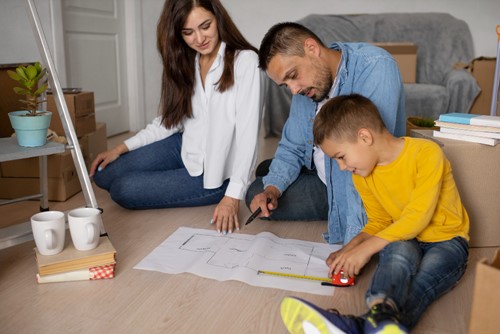Family-Friendly Home Design Tips
With a rise in the number of families opting to stay in their existing homes and renovate for more space, creating a family-friendly environment has never been more important.

But how do you strike the balance between stylish design and functionality that can withstand the chaos of little ones?
Here are some expert tips to transform your home into a haven that's both beautiful and practical for the whole family.
Flexible living spaces
Gone are the days of dedicated playrooms – modern families require adaptable spaces that can cater to a variety of needs. Here's how to achieve it:
* Multi-functional furniture: Invest in pieces that can serve multiple purposes, such as seating with built-in drawers and storage. Opt for nesting coffee tables that can be cleared out the way during playtime or spread around for adult gatherings.
* Zoning: Divide open-plan spaces into designated areas using rugs or furniture placement. Create a reading nook with comfy cushions in one corner and a designated play area with washable floor mats in another.
* Wall-mounted solutions: Free up floor space with wall-mounted shelves and bookcases for displaying toys and books. This keeps them within reach for little hands but prevents clutter from taking over.
Family-friendly bathroom design
The bathroom can be a high-risk zone for young children. Here's how to make it safe and functional.
* Non-slip flooring: Opt for textured tiles or invest in bathmats with a good grip to prevent slips and falls.
* Bathing considerations: Opt for a walk-in shower enclosure with a curtain or a child-safe glass door. This eliminates the need for a slippery bathtub and provides more space.
* Storage solutions: Install cabinets to keep toiletries and cleaning products out of small hands. Add sturdy hooks for hanging robes and towels at a child's height.
Child-centric storage solutions
Clutter is the enemy of a calm and stylish home. Implement these storage solutions to keep your space organised.
* Low-level shelving: Install shelves at a child's eye level for easy access to toys and books. Utilise clear bins and boxes for grouping items, making it easier for them to put things away.
* Labelled cubbies: Invest in cubby storage units with labels or pictures to help toddlers identify where their toys belong. This promotes independence and can instil good habits.
* Ottomans and toy chests: Double-duty furniture like ottomans and toy chests provide hidden storage for out-of-season toys and bulky items, keeping your living space tidy.
When selecting furniture and materials, prioritise rounded corners, non-toxic materials, and secure fastenings to prevent accidents.
By incorporating these tips, you can create a beautiful and functional home that caters to the needs of your entire family. After all, a happy and organised home environment fosters a sense of wellbeing for everyone living in it.